Mount Stewart, located on the shores of Strangford Lough in Ulster, is an impressive country house and garden that combines history, architecture, and some of the most outstanding gardens in the UK. As one of Northern Ireland’s most iconic landmarks, it provides a unique insight into the remarkable social life of the Stewart family and the unconventional feminist Lady Londonderry.
Table of Contents
The saga of Mount Stewart from past to present
Before going into the details of what to see at Mount Stewart House and Garden, I want to give you a brief summary of the history of this estate and the people who have owned it and shaped its history. Some of them, such as Lady Edith Londonderry, were really ahead of their time!
PLAN YOUR TRIP TO NORTHERN IRELAND
Stay connected in Northern Ireland with a giffgaff free SIM or an Airalo eSim for data coverage that works seamlessly throughout the whole UK. Plus, dive into everything you need to know about renting a car in Ireland, so you can easily explore incredible attractions like the Giant’s Causeway.
The Stewart family moved from Scotland to Donegal in 1744, purchased the property, and transformed the original house into a two-story building. They also added a walled garden, the Temple of the Winds, and several outbuildings for the farm.
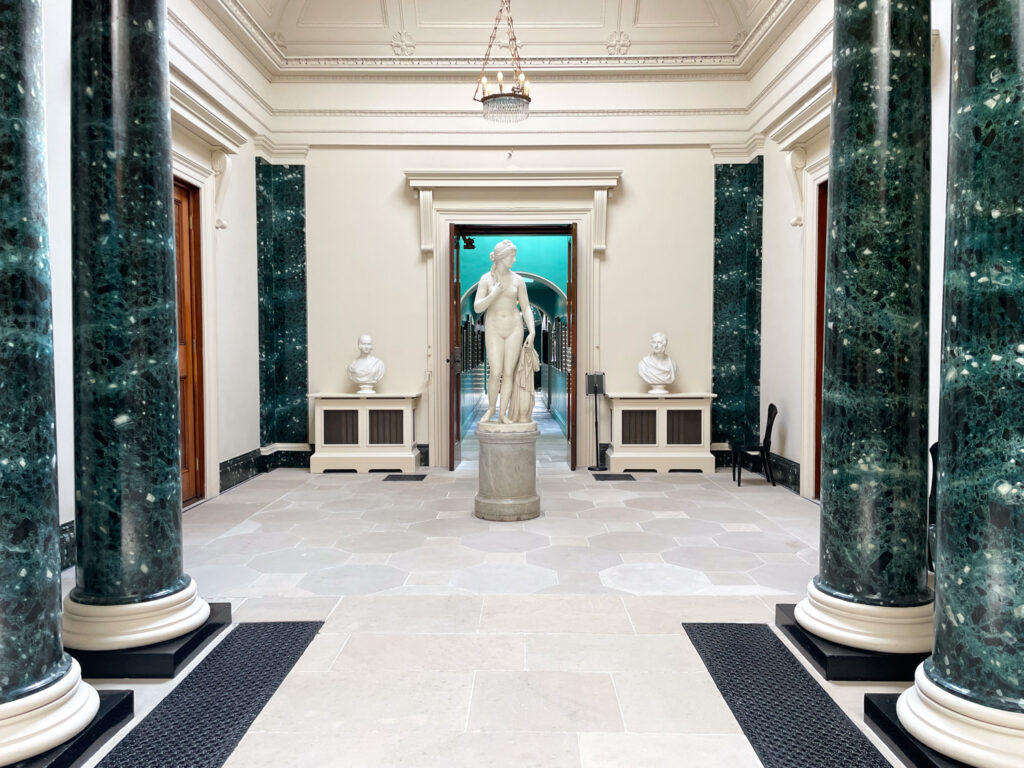
Charles Stewart and Frances Anne Vane-Tempest
In 1819, the 3rd Marquess of Londonderry, Charles Stewart, married Lady Frances Anne Vane-Tempest, the wealthiest heiress of coal mines at the time and the great-grandmother of Winston Churchill. He ordered an extension to the house, replacing the original structure.
Charles Vane-Tempest Stewart and Edith Chaplin
Other significant modifications occurred after 1920 when the estate passed to the 7th Marquess, Charles Vane-Tempest Stewart. As many of my readers are passionate about aviation like me, it’s worth noting that Charles Vane-Tempest Stewart was a pilot and became Secretary of State for Air in the 1930s. After World War I, his wife Edith, a well-known feminist and socialite, began to create the gardens and redecorate the house, as we can see today.
Mount Stewart today
Since 2009, the National Trust has managed the house and gardens as part of the settlement of Lady Mairi’s estate (the daughter of Charles Vane-Tempest Stewart and Edith Chaplin). The government accepted the estate and a significant portion of the house’s contents, including paintings and artwork, in place of inheritance tax.
Between 2010 and 2015, Mount Stewart underwent extensive renovation to present the house as a family home of the mid-20th century, preserving the interiors created by the Marquess and Marchioness of Londonderry, Charles and Edith Vane-Tempest Stewart.
Today, the Stewart family continues to reside in a wing of the house (closed to visitors) for six months each year. Our guide mentioned that they spend the rest of the year in Venice. Honestly, I am totally envious of this lifestyle!
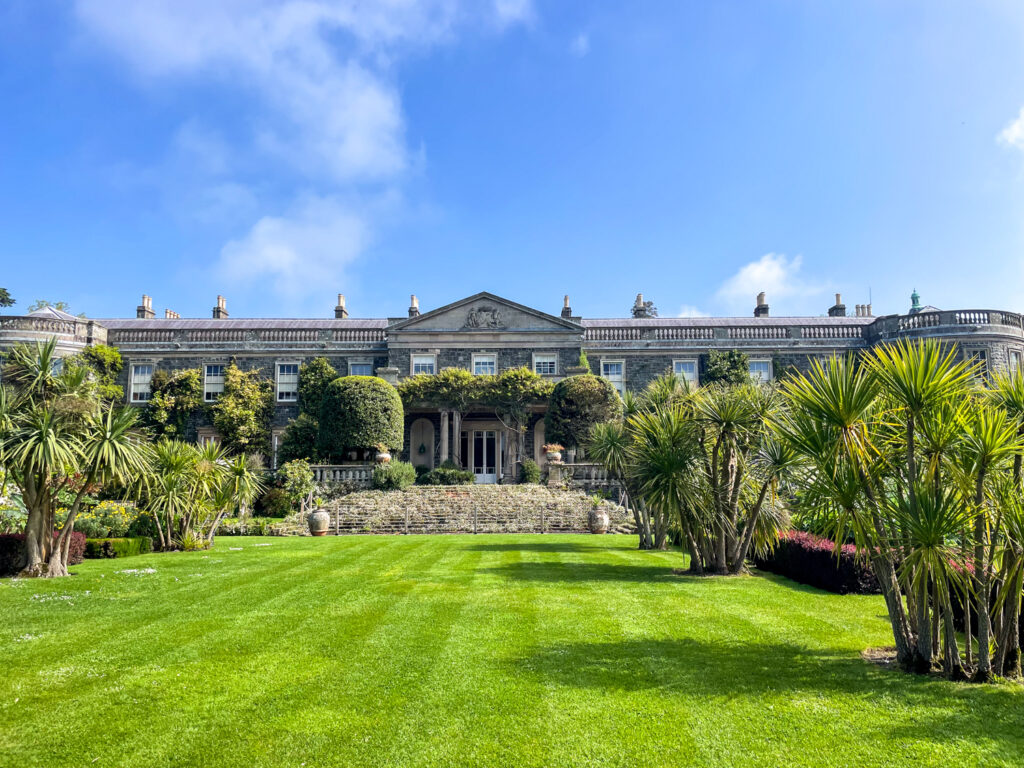
Lady Edith Vane-Tempest-Stewart: wife, mother, reformer, dreamer
The beauty of the Mount Stewart estate, as we can visit it today, is due to Lady Edith Vane-Tempest-Stewart, the 7th Marquess of Londonderry. She was a remarkable woman with a great passion for art, gardens, and architecture, as you can see at Mount Stewart.
However, Lady Edith did not merely decoher her estate. In fact, she made significant contributions to movements for gender equality, advocating for women’s suffrage, driving motor vehicles, and volunteering for many causes.
In 1903, she was one of the founding members of the Ladies’ Automobile Club, established by a group of aristocratic women. The club operated until the 1920s when the Royal Automobile Club absorbed it. Before World War I, Lady Edith was also a constitutional suffragist.
Women’s Volunteer Reserve
While her husband, Charles Vane-Tempest Stewart, served in World War I, Edith was appointed Colonel-in-Chief of the Women’s Volunteer Reserve, a group of women who took on roles traditionally held by men at the front.
The Women’s Volunteer Reserve was an organisation that attracted many women from higher social classes, creating an unusual mix of feminists and women who would not typically have associated with such a diverse range of people.
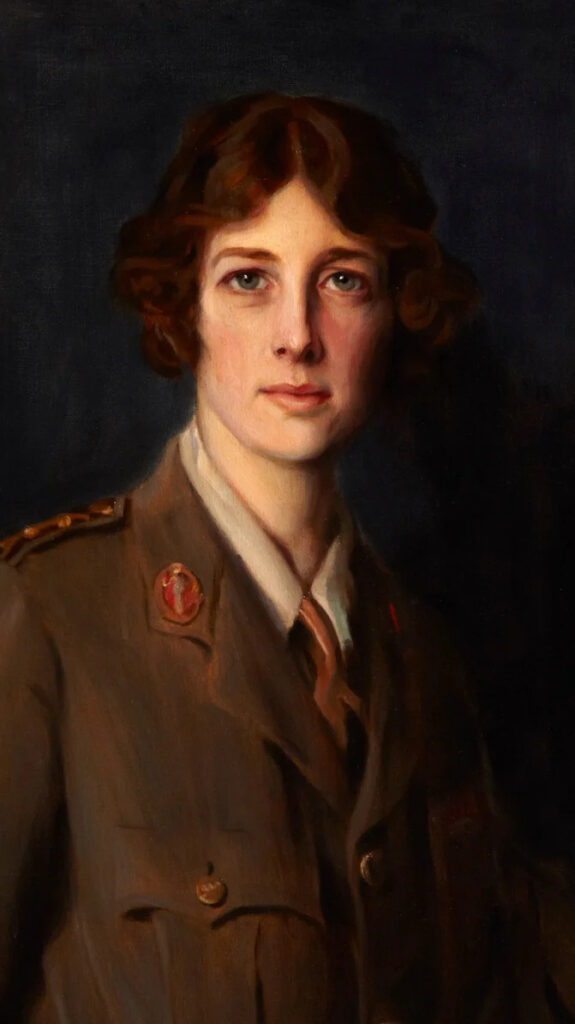
Women’s Legion
Later, Lady Edith Vane-Tempest-Stewart founded the Women’s Legion to replace men at the front with women in various roles, like the Women’s Volunteer Reserve.
The Women’s Legion was an umbrella organisation with several sections, including agriculture, motor transport, and gas. In 1916, the motor transport and military cookery sections came under the direct command of the Army.
It was not just a civic duty for women, but an opportunity to play a labour and social role precluded to them in peacetime. When the Army Council issued a call for 1,000 women to join the Women’s Legion, an astonishing 26,000 women enlisted, raising the total number to 40,000!
For her outstanding contributions, Lady Edith became the first woman to be honoured with the title of Dame Commander of the Order of the British Empire in 1917.
The Arc
As a socialite, Lady Edith hosted weekly dinners at her house in London for a group of friends called The Arc during WWI. This group included ministers, royalty, military personnel, writers, artists, and politicians.
Rather than serving as a political or intellectual salon, The Arc was deliberately frivolous and lighthearted. Each member adopted the name of an animal or mythological creature as a nickname, which often included a pun.
You can find sculptures representing the members of The Arc in Mount Stewart’s gardens. Lady Edith was known as Circe the Sorceress for her charm, while her husband Charlie was referred to as Charly the Cheetah because he was tall, elegant, and sleek as a cat, and his infidelities were also an open secret. Their famous friend Winston Churchill was Winston the Warlock.
A portrait by Edmond Brock depicts Edith in the garden as Circe, accompanied by her three younger daughters as sirens. In this painting, you can see the snake tattoo that Edith had inked along the left side of her body. This clearly shows how much she was out of the ordinary!
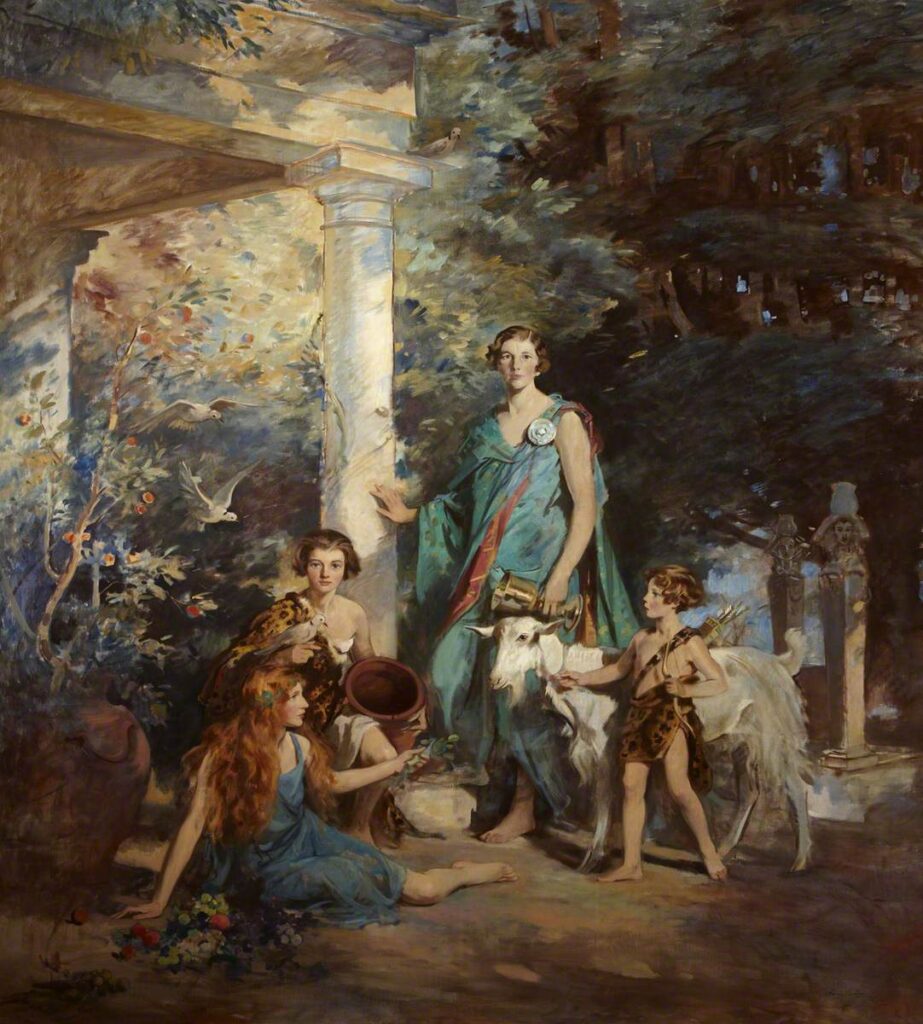
Mount Stewart decoration
Mount Stewart was Edith’s favourite residence. However, during her first visit, she found it the darkest and saddest place she had ever encountered in winter.
She later transformed the estate and hosted royalty, politicians, and nobles there. Lady Edith undertook extensive redecorating of the interior, including the large drawing room, the Castlereagh Room, and many bedrooms.
Mount Stewart House: architectural highlights
Generations of the Stewart family left their mark at Mount Stewart as it was the residence of the Marquesses of Londonderry for over 250 years. For this reason the house brims with stories and personal treasures. Still, it wasn’t just a family home.
In their dining room the Stewart family entertained famous guests, including royal family members. Inside the house’s grand halls and private sitting rooms, you’ll find impressive portraits and life-size sculptures.
After a significant restoration between 2010 and 2015, Mount Stewart returned to the splendour it possessed during the early 20th century, when Lady Edith Vane-Tempest Stewart, the 7th Marquess of Londonderry, lived there. The restoration project included repainting the walls, cleaning the textiles, and removing linoleum to reveal the original stone floor.
During your visit, you can learn how Lady Edith redesigned the house, transforming Mount Stewart into a vibrant space filled with art and family heirlooms, where family and esteemed friends could relax and escape public life. I assure you the house is really amazing, and below, I will detail some of the rooms that impressed me most during my visit.
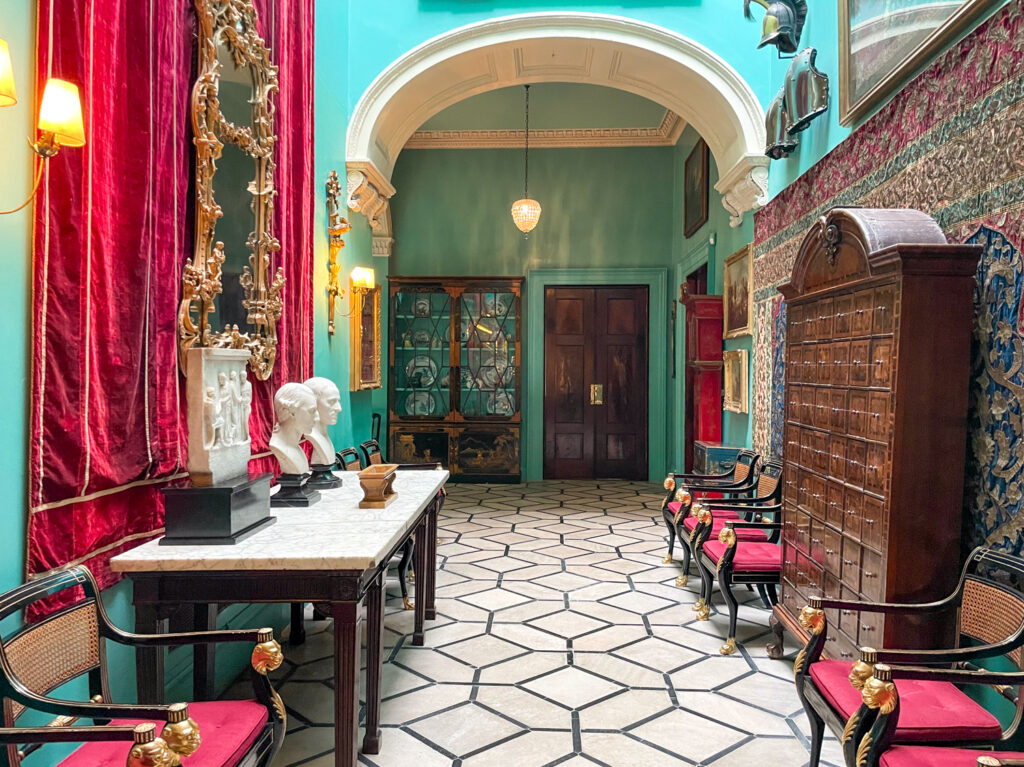
Dining room
The dining room hosted famous guests, including Winston Churchill and Neville Chamberlain, who later became Britain’s Prime Ministers. If you’re a history nerd, along the walls, you’ll be happy to spot the original chairs used during the Congress of Vienna in 1814–15.
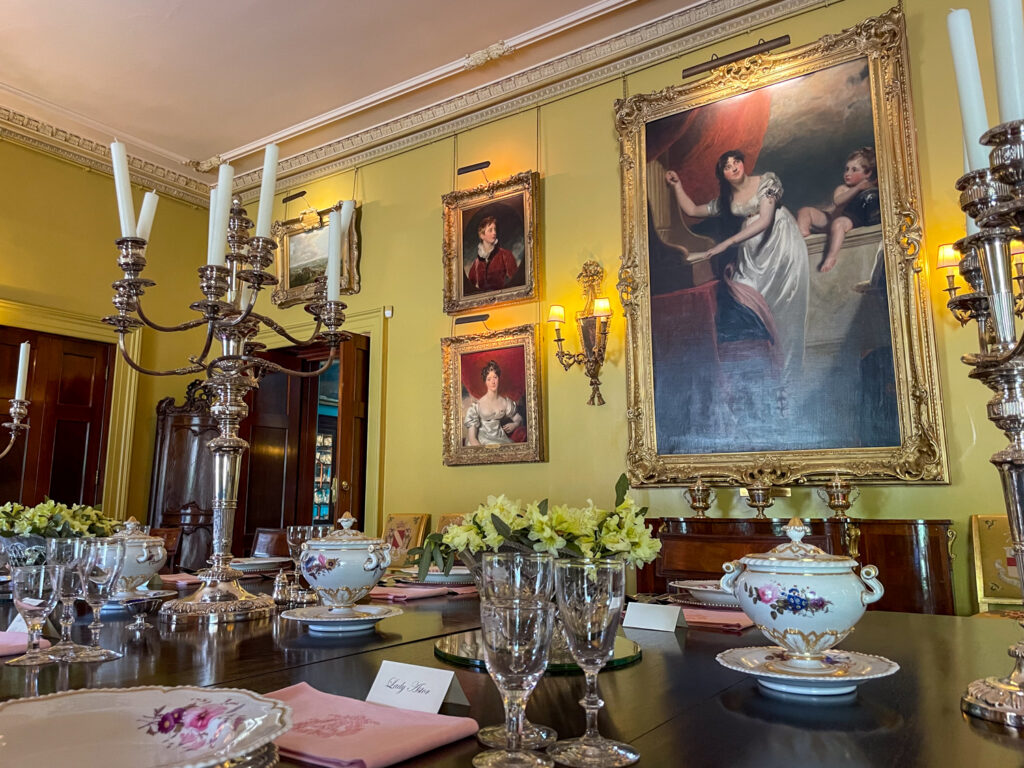
Lady Londonderry’s sitting room
In Lady Edith’s private sitting room, you can glimpse her many interests. The bookcases along the walls contain books on a wide variety of subjects.
Among them, you can find the first editions sent to Edith by their authors. Some of them are from the poet W.B. Yeats, the playwright George Bernard Shaw, and the novelist John Buchan.
Moreover, in her private sitting room, she researched, planned, and designed the world-class gardens for which Mount Stewart is now famous.
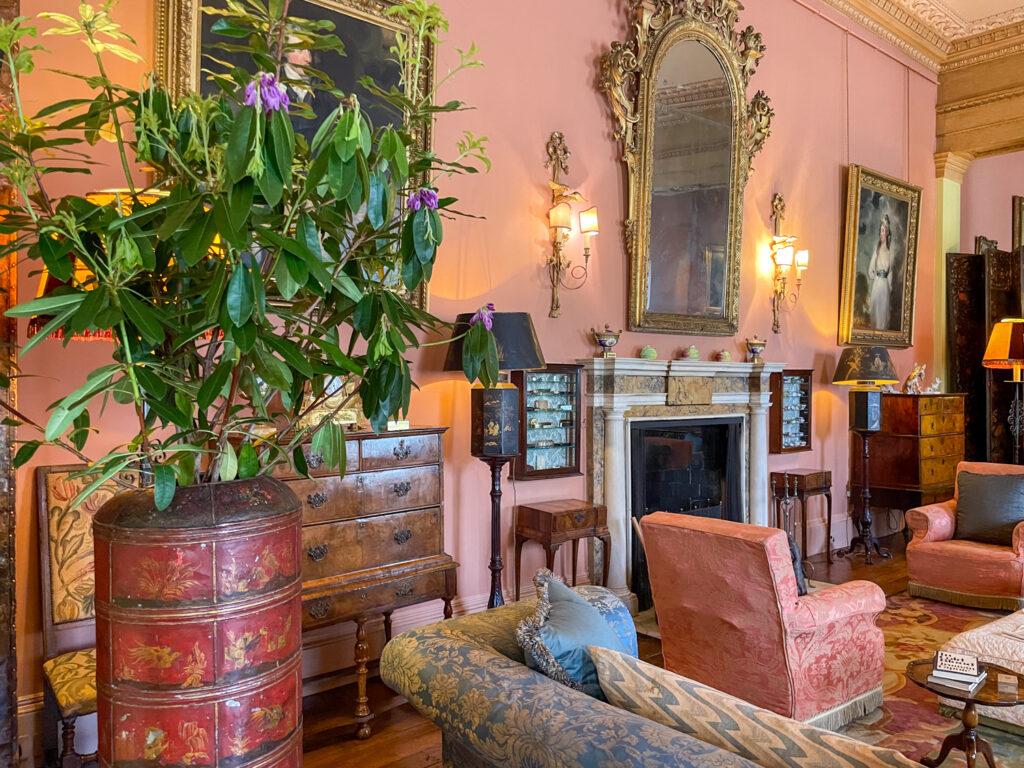
Chapel
During my visit, I was surprised to discover that the house has a private chapel too. Here, family marriages, christenings, and funerals took place.
Edith’s youngest daughter, Lady Mairi, married in the chapel in 1940. Also, her funeral in 2009 was held there, as well as Charles’s, who passed away in 1949, and Edith’s, who died in 1959.
Today, the chapel remains consecrated and is used for a communion service every month.
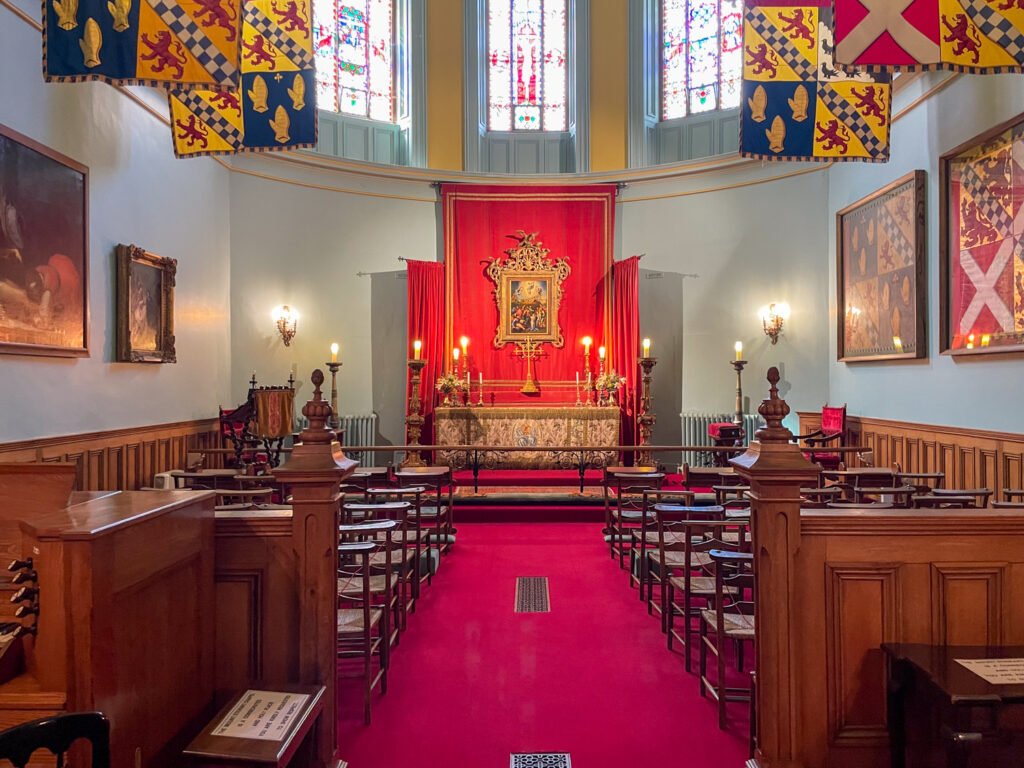
Bedrooms
The building has over 20 bedrooms, each named after cities and places that the 3rd Marquess Charles and his wife visited during their travels.
Some of the names include Turin, Genoa, and Rome, which reflect their trip to Italy, as well as Versailles, Lyon, Paris, and Calais, related to their journey to France. There are also bedrooms named after Moscow and Petrograd, as well as Cologne and The Hague.
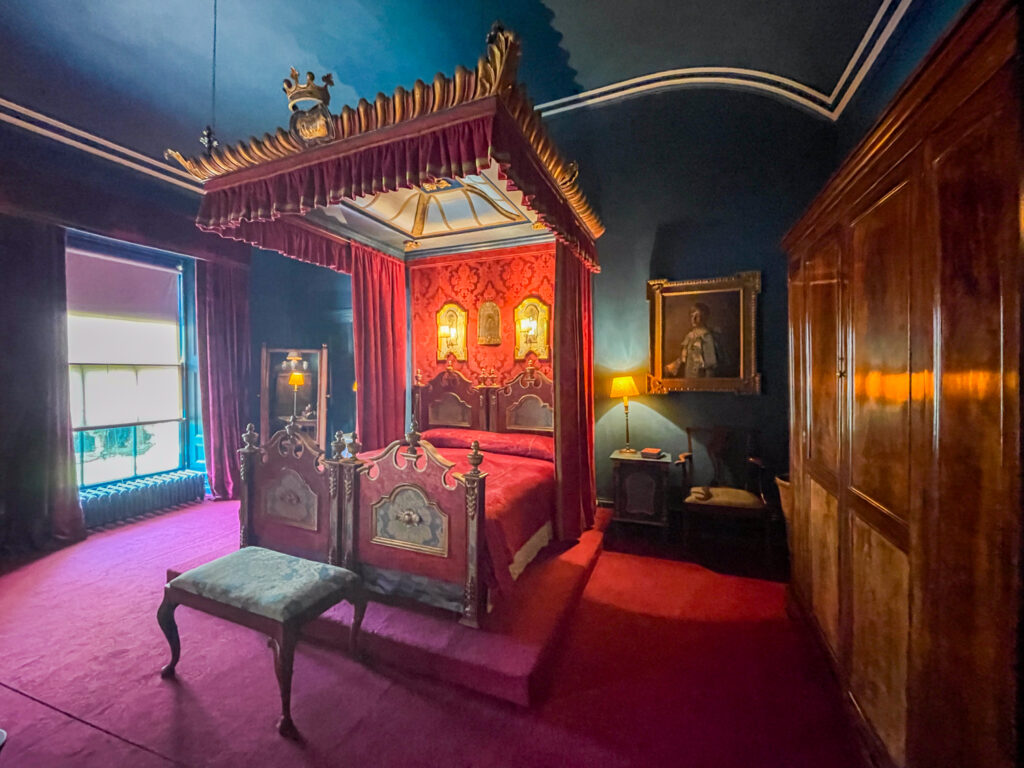
Mount Stewart Garden: Lady Edith’s legacy
Lady Edith Vane-Tempest-Stewart created the garden you can see during your visit after World War I. This garden is truly unique, offering different areas to explore, including fantastic statues representing members of The Arc.
Mount Stewart is situated on a peninsula, surrounded by the sea on both sides, which creates a relatively mild microclimate similar to that of the southwest of England. As a result, one of the most distinctive features of the garden is the presence of plants, not typically found at this latitude, showcasing vibrant colours from late-flowering winter blooms.
The park is divided into several zones, and below is a description of the ones I enjoyed the most during my visit. If you have more time available, it’s worth exploring Mount Stewart House and Garden the whole day, as they are wonderful places with so much to see.
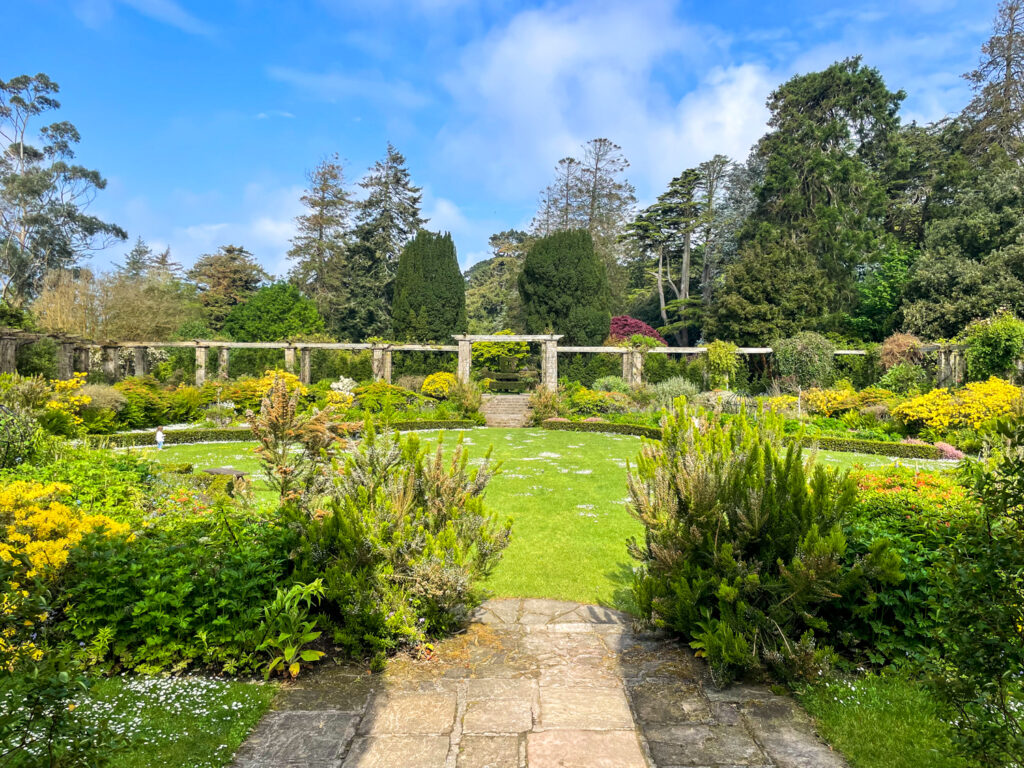
Shamrock Garden
In the sculpted topiary of the Shamrock Garden, you can find creatures from Irish mythology, characters from a children’s story, and figures inspired by Mary Queen of Scots’ prayer book.
Italian Garden
The Italian Garden is decorated with figures from Greek mythology. Lady Edith, known for her charm, was referred to by the Arc friends as Circe, the sorceress goddess from Homer’s Odyssey.
In the Odyssey, Circe transforms half of Odysseus’ crew into pigs, so in the Italian Garden, you can find statuary depicting the faces of Odysseus’ crew as well as Circe on the herms along the southern wall!
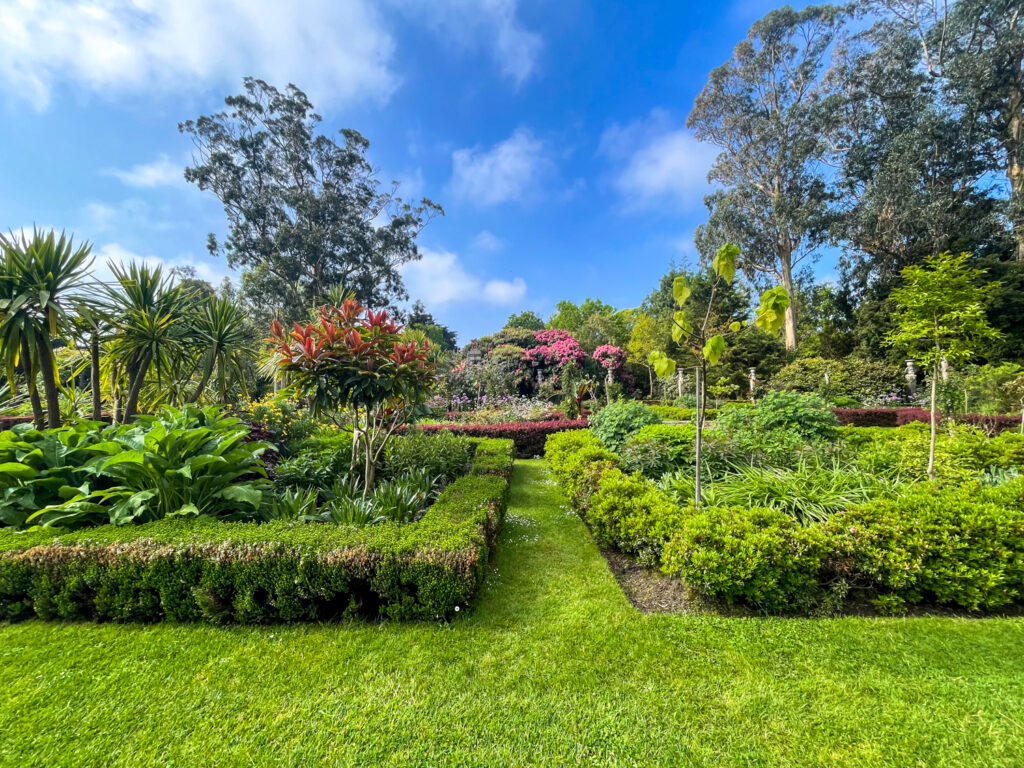
The Dodo Terrace
The Dodo Terrace is one of the most fascinating corners of the gardens of Mount Stewart, reflecting Lady Edith’s lightheartedness and sense of humour.
Throughout the Dodo Terrace, you will spot various creations in concrete and stone representing the members of The Ark, a weekly social gathering hosted by Edith during World War I, where participants adopted pseudonyms that were often puns based on their names.
The Dodo refer to Edith’s father, caricatured as this extinct animal after serving for 35 years in the House of Commons in 1903.
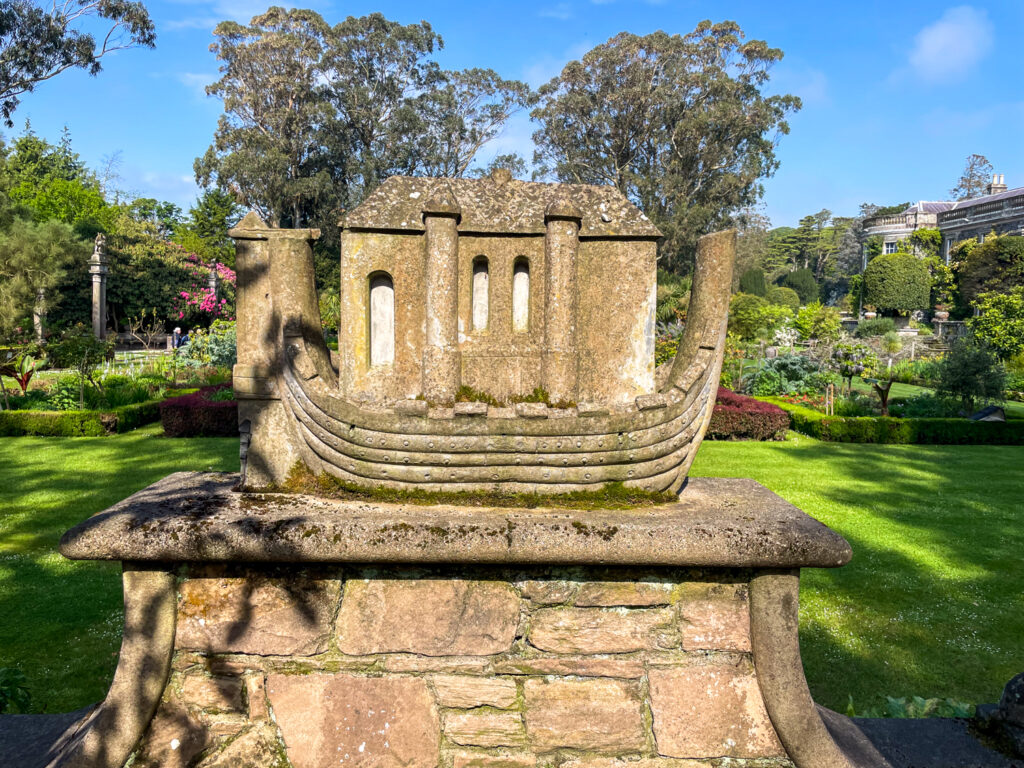
How to plan your visit to Mount Stewart
Planning a visit to Mount Stewart is quite simple. I recommend spending the whole day there if you have enough time during your trip. During my half-day visit, in fact, I didn’t have enough time to explore the entire garden or fully appreciate the house.
If you decide to spend the whole day at Mount Stewart, don’t worry about lunch because a tea room on the estate is open seven days a week, offering takeaway and sit-in dining options. If you visit Mount Stewart on a sunny day, you can enjoy a picnic, as there are plenty of picnic tables and spots to lay out a blanket.
Additionally, there’s a gift shop that offers a variety of gifts, homewares, and local crafts. I purchased the Mount Stewart visitor’s guide there and highly recommend it. I always buy the National Trust guides during my visits, as they are very interesting and filled with valuable information. The price is usually quite reasonable, typically around £5 at most locations.
Opening hours
Mount Stewart House is open for visits from 11:00 am, with the last entry at 3:15 pm. Meanwhile, the Garden is accessible from 10:00 am to 4:00 pm.
How much the tickets cost
Tickets to visit Mount Stewart cost £15.00 for adults and £7.50 for children, while children under five can enter for free. Additionally, there are discounts for families and groups, making it more affordable for larger parties to enjoy their visit.
If you are a member of the National Trust, you can enter free of charge. The membership allows you to visit over 500 locations across the UK and also provides free parking at most National Trust car parks. I signed up one year I spent the summer in England and it was very convenient. Also, the free memberships invite you to discover lesser-known places that you might not consider because of the price.
Visiting Mount Stewart with children
I visited Mount Stewart without my son because I was on a trip with friends. However, the estate was incredibly family-friendly, like almost all National Trust properties in the UK. There are seasonal activities and events specifically for children.
The estate features accessible, buggy-friendly paths around the lake and gardens, leading up to a Natural Play area where kids can enjoy themselves freely. Although some woodland areas may be challenging for buggies, the overall layout is accommodating.
One thing I really love about the UK is that high chairs and children’s meals are widely available, and the Tea Room at Mount Stewart is no exception. If you are travelling with younger children, you will also find baby-changing facilities in the restrooms.
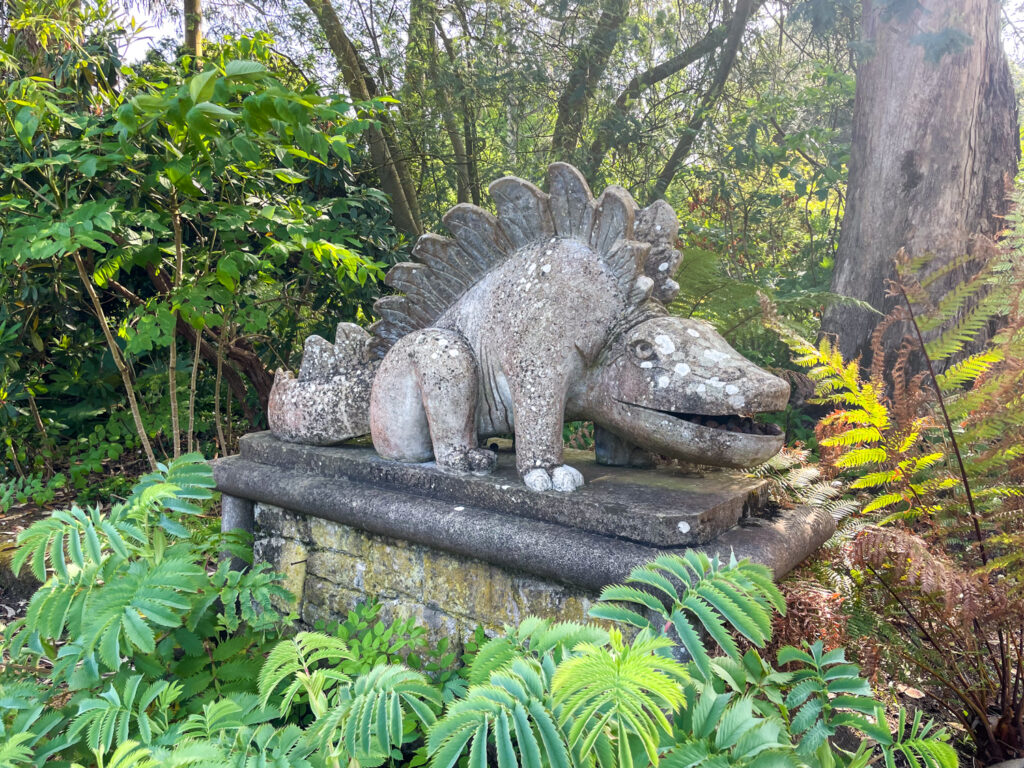
How to get to Mount Stewart
The best way to reach Mount Stewart is by car, as it is located just 15 miles southeast of Belfast. There is ample free parking available on-site.
However, your SatNav or GPS may direct you to the back gate of Mount Stewart, which is not accessible to the public. We had trouble to find the right entrance using Google Maps.
Mount Stewart is situated on the Portaferry Road in Newtownards, headed towards Greyabbey. To find it, stay on the coastal road Portaferry Road, and look for the Mount Stewart signposts. To be honest, they aren’t very big, but after going back and forth on the road a couple of times we managed to find the right entrance.
Public transport
Alternatively, there is a bus service from Belfast to Portaferry that stops right in front of the gates. You can find this route by entering “Cunningburn, Mount Stewart” on the Translink NI website.
If you’re travelling by train (not the best option in Ireland, in my opinion), the nearest train station is Bangor, which is 10 miles away, and then you can move by bus. Again, the Translink NI website is the right place to plan your trip.
Mount Stewart House and Garden
Portaferry Road, Newtownards, County Down, BT22 2AD

In conclusion, Mount Stewart House and Garden is an incredible destination in Ulster for a fantastic day out, where you can learn about history and be amazed by the lush garden. Feel free to share your thoughts and experiences about Mount Stewart and the extravagant lifestyle of Lady Edith Vane-Tempest-Stewart in the comments.

2 comments
An incredible place where to spend a day!
Yes, next time we should spend the WHOLE day!!!